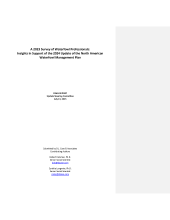
A 2023 Survey of Waterfowl Professionals: Insights in Support of the 2024 Update of the North American Waterfowl Management Plan
FINAL REPORT
Update Steering Committee
July 13, 2023
Executive Summary
We administered an online survey to waterfowl professionals in April of 2023 to gather input to support the 2024 update of the North American Waterfowl Management Plan (NAWMP). The questionnaire replicated several questions previously asked in 2017. Overall, we received a low response rate resulting in a small sample which limited the ability to: 1) compare results to look for trends; and 2) perform many crosstabulations to segment the audience based on respondents’ individual characteristics. Still, the results provide some clear direction and guidance for the 2024 plan update.
- Most of the respondents (82%) were from the United States. Many of the responses came from biologists/scientists (43%), providing context for the results, which tend to prioritize habitat and population assessment over other strategies (e.g., relationship building, policy, etc.) as observed in response to several survey questions.
- Two-thirds of respondents were very or somewhat familiar with NAWMP. Early career professionals and those working for state agencies were less familiar than others and represent a target audience for information and ways to become more engaged with NAWMP.
- A strong majority endorsed all three of the plan’s goals as important to continue forward, and generally assigned some improvement in progress towards the seven attributes evaluated under each goal, though few people thought significant progress has been on any goal in any area.
- Seven of the eight recommendations from the 2018 NAWMP Update were also endorsed as important to include in the 2024 update.
- While survey respondents expressed general support for the plans’ goals and recommendations on Likert scale ratings of importance, the survey comments suggest a more nuanced assessment among professionals. Numerous comments pointed out that the current wording of goals and recommendations is:
- Vague
- Imprecise
- Double-barreled (and in some cases conflicting)
- Lacking prioritization or actionable steps
- Most of the survey respondents rated the performance of the Flyway system and Joint Ventures as “Excellent” or “Good”, yet three-quarters (75%) also said improvements were needed in coordination of the two bodies. Some survey comments elaborate on this theme.
- A majority rated the performance of Waterfowl Monitoring, the Adaptive Harvest Management system, and collaborations between the U.S. and Canada as “Good” or “Excellent”. When asked to rate collaborations between Canada and Mexico or Mexico and the U.S., a majority of respondents selected “Don’t Know.”
- Habitat management and technical support were two areas where respondents saw the most progress in the implementation of NAWMP, yet when asked, they also wanted greater emphasis placed on these areas.
- Habitat management was the most highly ranked strategy among a list of 16 for greater emphasis going forward.
- Survey comments suggest there remains a need to monitor and evaluate the connection between habitat work and waterfowl population response at multiple spatial scales.
- Survey respondents identified collaborations with stakeholders as the biggest area in need of change to advance waterfowl management. Half of the respondents said a moderate amount of change was needed in collaborations with stakeholders. Yet when asked to rank which priorities needed more emphasis in the 2024 Update, various stakeholder strategies ranked near the bottom.
- From survey comments, it appears there is a lack of conceptual understanding and agreement about what Human Dimensions or Social Science can and should do with respect to plan implementation.
- Most seem to think they need it but are not sure for what.
- Others expressed lack of capacity or expertise on how to pursue it.
- Still other comments reflect an assumption that meaningful behavioral change at individual or societal levels will occur if people are presented more information about the value of wetlands.
- The respondents to this survey were less engaged with service on waterfowl and bird conservation committees than in the 2017 survey. It is hard to say whether this represents a real trend, a difference in audience composition compared with 2017, or an anomaly, but it should be monitored.
